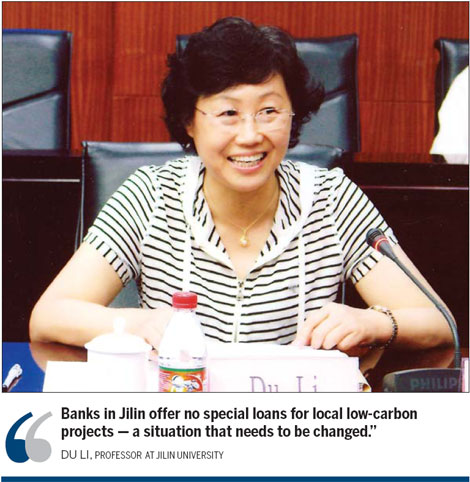Academic: Carbon trading could transform northeast
With traditional heavy industries that rely on intensive consumption of resources, Jilin province in northeast China could help the move toward sustainability through trading in carbon emissions, according to a proposal from an academic in the province.
 |
Du Li, a professor with Jilin University, has proposed that the provincial government work with financial institutions to build a carbon finance mechanism that would help reduce emissions.
Carbon trading enables enterprises to buy or sell credits - with those below the emissions cap able to sell to those who need more.
International emissions trading was first recognized in the Kyoto Protocol, adopted in 1997 as part of the United Nations Framework Convention on Climate Change and that entered into force in 2005.
Major carbon exchanges worldwide include the European Union Emission Trading Scheme, the UK Emissions Trading Group, the Chicago Climate Exchange and the Australian Climate Exchange.
Managing one of the aging industrial centers of the nation, Jilin's government has spent substantial funds for pollution treatment equipment and made marked progress.
Yet "it is still not enough", Du said, as more environmental programs and eco-friendly industrial projects are needed that could be helped by financial institutions.
For the local government of Jilin, Du said that it is a necessity to borrow ideas from the international carbon market and establish a carbon trading market inside the province.
Enterprises that have surplus carbon credits could sell them as a reward for effective management of emission reduction, while companies that fail to control carbon emissions below the defined cap would have to spend extra money to buy credits and avoid punishment.
The prerequisite is to set a price for greenhouse gas emissions, as well as the upper limit of carbon dioxide that an enterprise is allowed to discharge, Du added.
The Kyoto Protocol also raised a Clean Development Mechanism (CDM), under which developed countries could offset their emissions by investing in low-carbon projects in developing countries like China, India or those in Latin America.
CDM in China
According to Du, China has become the largest recipient of CDM projects in the world with more than 2,300 projects approved by National Development and Reform Commission by the end of 2009, among which 41 are located in Jilin.
"Banks in Jilin offer no special loans for local low-carbon projects - a situation that needs to be changed," Du said.
She suggested that the province establish a carbon fund - a new kind of fund that has already been operating in some Western countries, like the Netherlands and Germany.
Du said that the province could start with setting up small-sized carbon funds or inviting well-established funds from overseas in an effort to support CDM projects that have promising prospects.
Another approach to CDM projects would be encouraging commercial banks to create new financial products that bundle scattered funds and form a special carbon fund offering loans to enterprises that undertake CDM projects and have good credit, she said.
In 2006, the International Finance Corporation, a part of the World Bank Group, initiated the China Utility-Based Energy Efficiency program with Industrial Bank as its first local partner in the program.
According to Du, Industrial Bank has offered 900 million yuan loans to 46 energy efficiency projects in China - mostly run by small and medium-sized enterprises. She suggested the SMEs in Jilin could apply for such loans as well.
Also among Du's recommended choices is to invite insurance companies to join the cause of low-carbon economy by providing insurance for CDM projects in Jilin. Carbon permits buyers and enterprises that carry out CDM projects are eligible to application for the insurance.
In addition to an effective carbon finance system, Du said that the government should also offer related tax favors, subsidies or other preferential policies as well as increase investment in technology research to ensure a successful transition from traditional economy to low-carbon economy.
 0
0 






